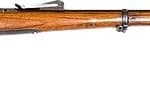
"Belgian carbine M1848" by Armémuseum is licensed under CC BY 4.0 .
Introduction
The mid-19th century was a time of extraordinary innovation in firearms design, marked by the shift from flintlock to percussion ignition, the emergence of rifling in military arms, and the widespread adoption of more efficient and reliable weaponry. While many firearms of this period gained historical recognition, the so-called Model 1848 Belgian Carbine remains an obscure yet fascinating relic of this transformative era.
Produced in Belgium, a nation with a rich tradition of firearms manufacturing centered in the city of Liège, this carbine played a role in the development of European and American military weaponry. Although overshadowed by better-known contemporaries such as the Springfield Model 1842 and the Enfield Pattern 1853, this firearm demonstrated forward-thinking design elements that influenced later developments in cavalry and infantry arms.
Development and Historical Context
By 1848, European and American military forces were rapidly adopting percussion-fired weapons to replace outdated flintlock arms. Belgium, home to one of the world’s most prolific firearms industries, had already been producing high-quality arms for various European nations, including France, the Netherlands, and Prussia. Belgian gunsmiths, particularly in Liège, were well-known for producing high-quality military arms, often on contract for foreign governments.
The Model 1848 Belgian Carbine emerged as part of Belgium's ongoing efforts to modernize its cavalry and infantry firearms. It was a response to the evolving needs of mounted troops, who required a weapon that was compact, reliable, and faster to reload than the traditional flintlock muskets still in limited use at the time.
Although historical records do not explicitly list a standardized "Model 1848" in Belgian military procurement, evidence suggests that a series of percussion carbines produced in Belgium around this period followed similar design principles. Some of these carbines were manufactured for foreign buyers, particularly in the United States, where Belgium played a role in supplying arms before and during the American Civil War.
Manufacture and Design
Liège: The Heart of Belgian Firearms Production
The Liège arms industry, a crucial center of European gunmaking since the 14th century, was home to numerous independent manufacturers producing military rifles and carbines. While the famous Fabrique Nationale d'Armes de Guerre (FN Herstal) would not be established until 1889, earlier companies such as Auguste Francotte, Ancion & Co., and Pirlot Frésart were at the forefront of Belgian gun manufacturing in the mid-19th century. These firms were responsible for crafting thousands of military rifles and carbines, supplying both the Belgian army and international clients.
The Model 1848 Belgian Carbine was constructed with a percussion lock mechanism, a major improvement over flintlock designs. This system, which used a small copper cap filled with mercury fulminate to ignite the gunpowder charge, significantly enhanced the firearm's reliability, particularly in wet or adverse conditions.
Technical Specifications
- Caliber: Approximately .58 to .60 caliber, depending on variant
- Barrel Length: Ranged from 20 to 24 inches
- Overall Length: Around 40 inches, making it ideal for mounted troops
- Weight: Approximately 7.5 to 8.5 pounds
- Ignition System: Percussion cap lock
- Ammunition: Typically used a Minié ball or round ball with black powder
- Stock Material: European walnut
- Rifling: Some versions featured rifled barrels, while others remained smoothbore
The shorter barrel length made this carbine well-suited for cavalry units, allowing easier maneuverability on horseback. Some versions were equipped with sling swivels to facilitate carrying, and depending on the client, minor design variations existed.
Performance and Tactical Role
Range and Accuracy
The rifled versions of the Model 1848 Belgian Carbine had an effective range of 200 to 250 yards, though in practical battlefield conditions, engagement distances were often much shorter. By contrast, smoothbore versions were accurate only up to 50 to 100 yards, similar to earlier cavalry carbines.
Rate of Fire and Reliability
Thanks to its percussion ignition system, the Model 1848 had a higher rate of fire than older flintlocks, allowing a trained soldier to fire two to three rounds per minute. The robust construction and high-quality craftsmanship made it reliable in adverse weather conditions, a crucial advantage for troops operating in wet or muddy environments.
Use in Conflicts
Adoption by European and American Forces
Belgium was a major exporter of firearms, and many Belgian-made carbines found their way into the hands of foreign armies. The Model 1848 Belgian Carbine, or variations thereof, is believed to have been supplied to both France and Prussia, as well as smaller European states seeking to modernize their forces. Some of these carbines may have been used during the Franco-Austrian War of 1859 and the early phases of the Franco-Prussian War (1870-1871).
Possible Role in the American Civil War
While not a primary firearm of the American Civil War (1861-1865), Belgian percussion carbines were known to have been imported into the United States in limited quantities. Some Confederate and Union cavalry units used European carbines alongside domestic models such as the Sharps 1859 Carbine and the Burnside Carbine.
Comparison with Contemporary Firearms
Springfield Model 1842
The U.S. Model 1842 was the first mass-produced percussion musket for the U.S. Army and was a smoothbore weapon, whereas some Belgian carbines were rifled. The Springfield had a longer effective range but was bulkier and less suitable for cavalry use.
Enfield Pattern 1853
The British Enfield 1853 was a rifled musket used extensively in the Crimean War and the American Civil War. While superior in accuracy to the Belgian carbines, it was longer and less practical for mounted troops.
Chassepot 1866
The French Chassepot 1866, a later development, was a bolt-action breechloader and far superior in rate of fire and range. However, its complexity and cost made it less widely available than simpler percussion carbines.
Legacy and Collectibility
Today, surviving examples of the Model 1848 Belgian Carbine are relatively rare, but they remain sought after by collectors interested in European military firearms of the 19th century. Their historical significance lies in their role as a transitional firearm, bridging the gap between early percussion muskets and later breech-loading designs.
Belgium's legacy as a leading arms producer continued into the 20th century with the establishment of FN Herstal, which became one of the world’s most respected arms manufacturers. The influence of Belgium's mid-19th century firearms industry is still evident in modern weapons production today.
Conclusion
The Model 1848 Belgian Carbine represents a fascinating chapter in firearms history, embodying the innovation of Belgian gunsmiths in the mid-19th century. While overshadowed by better-known rifles, this carbine played a key role in the evolution of military arms, particularly in cavalry warfare. Its combination of percussion ignition, compact size, and effective range made it a formidable weapon for its time.
Although not as widely documented as other firearms, the Model 1848 Belgian Carbine deserves recognition for its impact on 19th-century military technology and its place in the broader story of Belgian arms manufacturing.
To join the discussion on this type of weapon, click here.
If you know of any forums or sites that should be referenced on this listing, please let us know here.



